Can You Hear Me Now? - Implications of New Research in Greek Theatrical Masks
by Amy R. Cohen
Randolph College, Lynchburg, Virginia
In 2006, I undertook a summer research project with two aims: 1) pull together the available scholarship in order to recreate Greek theatrical masks; and 2) to construct, using that method as far as practicable, full usable masks for the cast of The Clouds to be performed using original practices. My student researcher, Naomi Fritts, and I accomplished goal 2 (with the help of the cast and crew), and the masks were so effective that we may have shown that we succeeded in goal 1 as well.
The sources for ancient masks are, of course, regrettably few. We used what little text evidence there is, particularly the Suda entry on Thespis, which says that the playwright introduced masks constructed of linen, and looked closely at extant imagery. Many mask pictures are from much later than the original productions and we confined ourselves to the vases that are most contemporaneous with extant plays and that show masks as masks, rather than simply as the integrated head of a character, in particular the Pronomos vase from the end of the fifth century (A.R.V.2 1336.1). We also followed the same logic that many of the scholars and practitioners mentioned below have used: the masks must have been constructed of something not capable of surviving in the archaeological record; they must have been light enough to be worn without too much discomfort; their materials must have been able to have been carved or moulded into a permanent shape that could also be decorated.
After several weeks of experimenting with different materials that we thought the ancient evidence allows (see the account at http://greekplaymasks.blogspot.com), we arrived at a method that produces masks made of birdseye-weave cotton stiffened with wheat paste that are supported on the head by wooden dowels, some of which are connected to a skullcap structure.
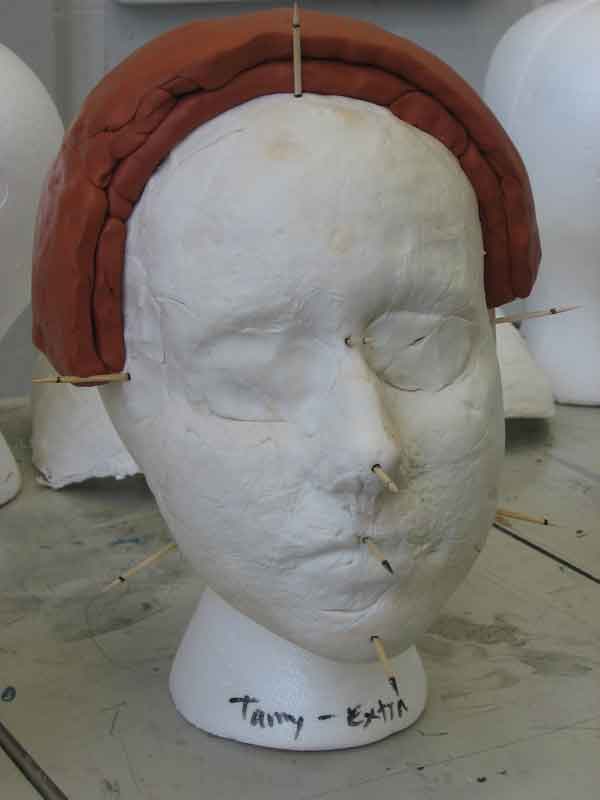 |
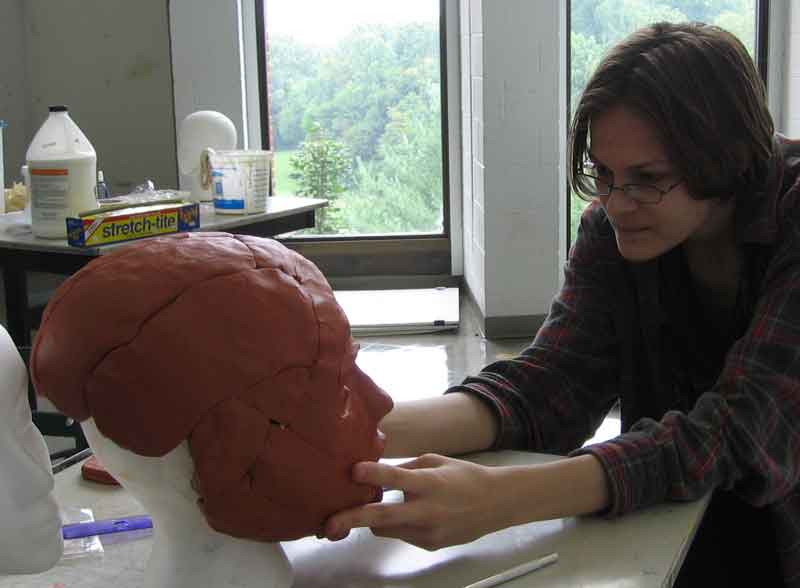 |
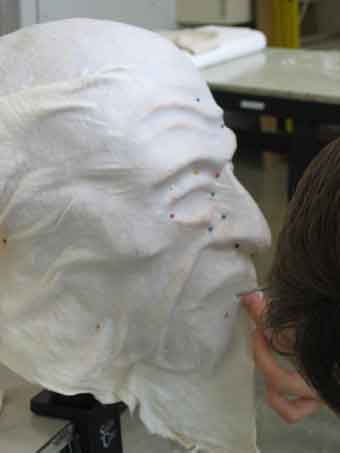 |
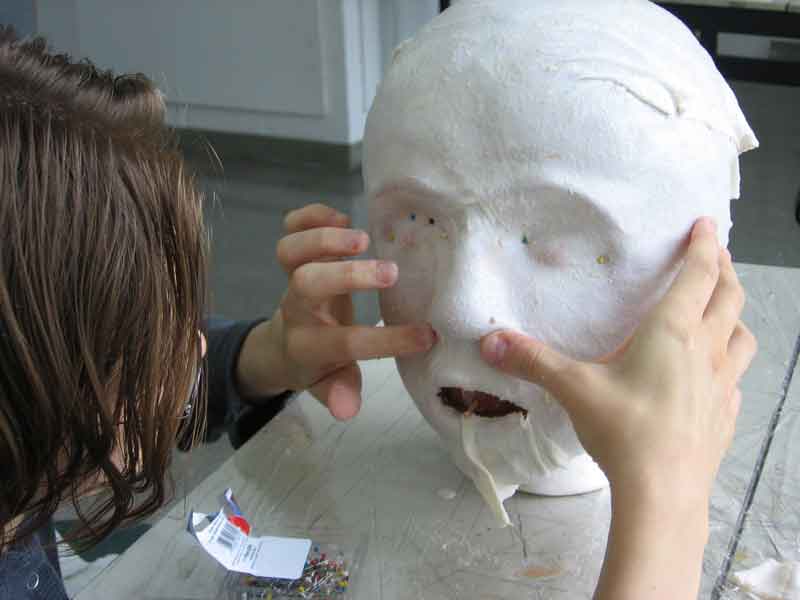 |
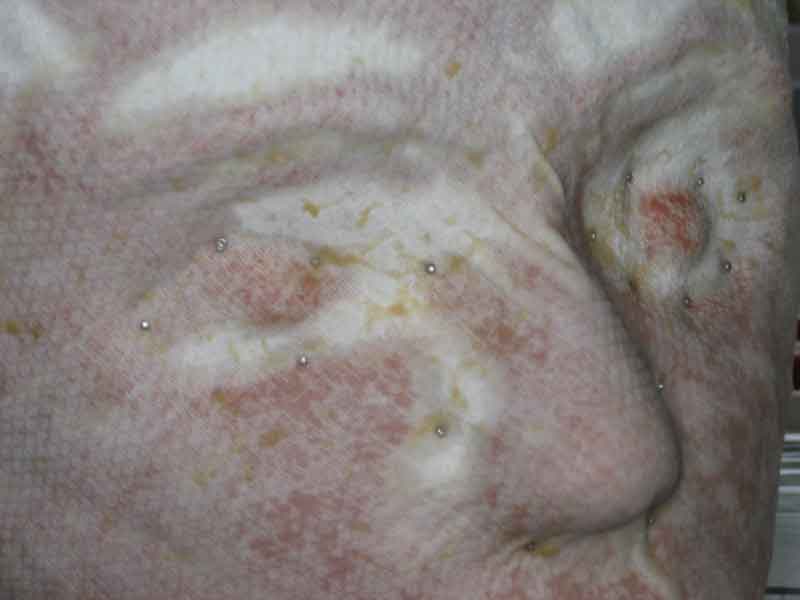 |
||||
| Plate 1 | Plate 2 | Plate 3 | Plate 4 | Plate 5 |
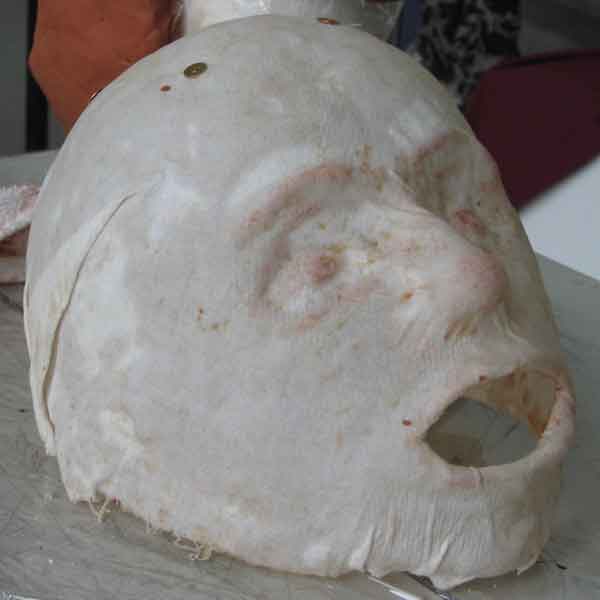 |
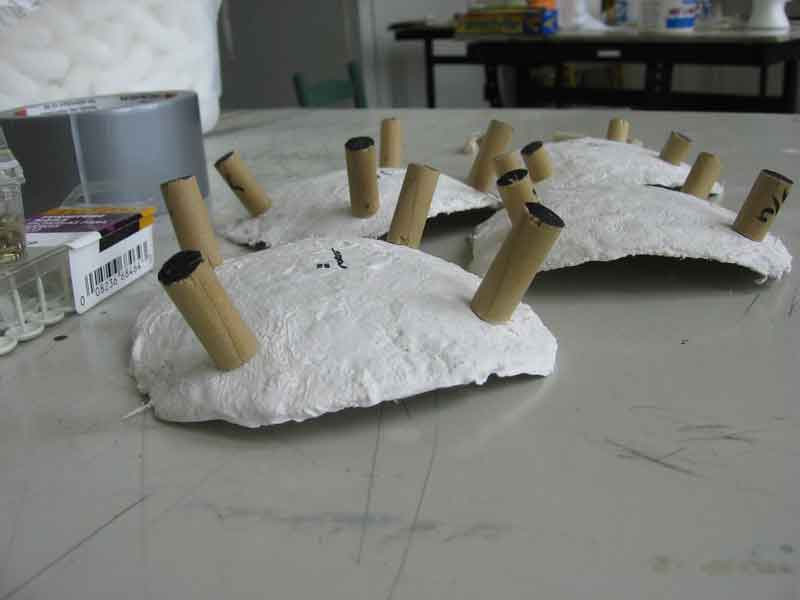 |
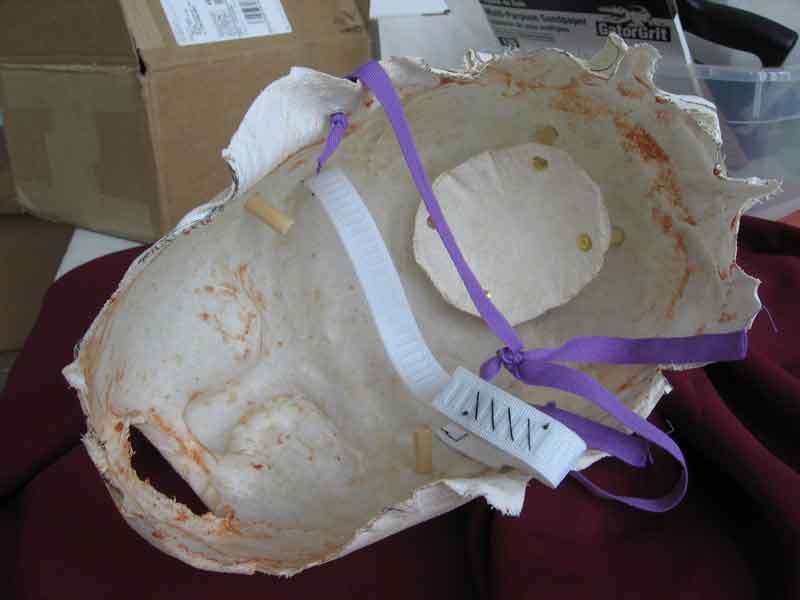 |
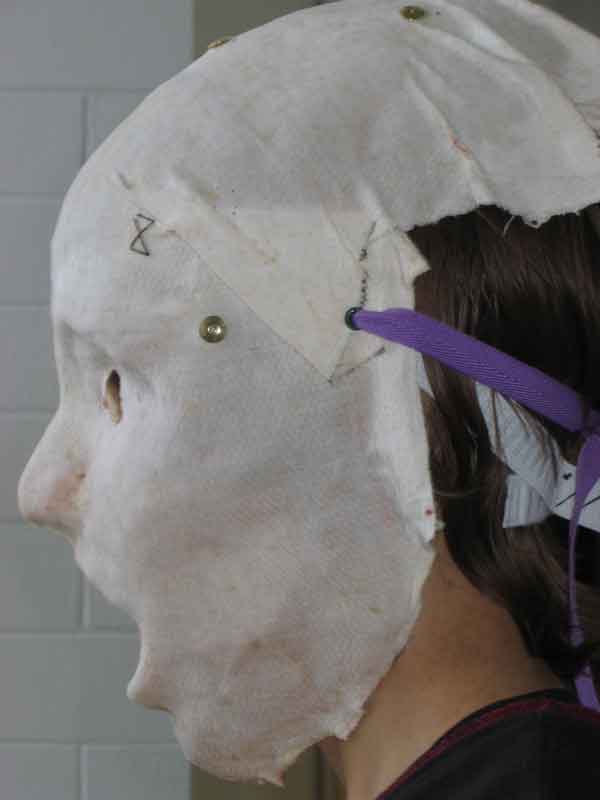 |
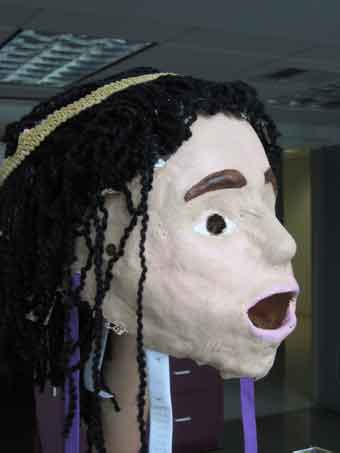 |
||||
| Plate 6 | Plate 7 | Plate 8 | Plate 9 | Plate 10 |
A mould of the actor’s face is built up with an inch of clay (Plates 1 & 2), after which the clay is draped with glue-soaked cotton (Plates 3 & 4). Straight pins keep the wet fabric in deep contours until the glue hardens (Plate 5), when the mask is removed from the clay mould (Plate 6). In designing the skullcaps (Plate 7), we followed the ideas of Michael Chase as documented by Chris Vervain and David Wiles in “The Masks of Greek Tragedy as Point of Departure for Modern Performance” (New Theatre Quarterly 67 (2001) 254-272), although our skullcaps are much smaller than the one illustrated in Figure 7. Two ties (Plates 8 & 9) are used: one pulls down from the inside of the forehead to the base of the actor’s neck (to seat the skullcap firmly on the head), and one from the temples to the back of the head. Our first masks tried mouth openings of 1 inch, 1½ inches, and 2 inches high, and eye holes approximately an inch in diameter. The wigs are made of yarn on a muslin base. Plate 10 shows a completed prototype.
By virtue of a Greek Play tradition going back to 1909, we have a Greek theatre at our disposal (Plate 11).
 |
|
| Plate 11 The Greek Theatre, Randolph College, during a performance. | |
Its orchestra is roughly the size of the playing space at the Theatre of Dionysus, and although the hill that supports the theatron is not nearly as big as the south slope of the Acropolis, we have played to an audience of 1,100 with room to spare. When we finally took our first, full-sized prototypes out to the theatre, we were gratified at how little the volume of the voice seemed to be diminished.
We had three different people try on the mask and speak the same words. We did not have the foresight to record the event, but we had the trained ear of our music director and college voice professor Randall Speer. He noticed differences between the sounds depending on the size of the mouth, and we rejected the smallest we had made (a one-inch high opening). He noticed that the sound was more distinct if the voices were in lower registers—a difference also noticed by Greg McCart in the papier-mâché masks by Victoria Bradbury—which fits well with masks made for fifth-century all-male casts, but which might pose challenges for our all-female one. And it made a difference how big the actor's head was in the mask, which confirmed that a consistent space around the head contributes to whatever resonating qualities we could achieve. Richard Williams, in "Digital Resources for Practice-based Research: The New Comedy Masks Project" (Literary and Linguistic Computing, Vol. 19, No. 3. 2004) extrapolates from New Comedy figurines a one-centimetre gap around the head, but we chose a one-inch gap as large enough for the amount that the jaw moves during speech and song and not so large as to over-exaggerate the size of the head or lose the resonating qualities we were pursuing. We were enormously pleased that a prototype that seemed to approximate the ancient reality caused no difficulty in being heard or understood; they were no hindrance, in fact.
The great surprise was the extent to which the masks are an actual help for a problem of the Greek theatre: in the great curved sweep of the orchestra, actors, unless they stay far up stage, must often have their backs to at least part of the audience. The argument has, in fact, been made that masks require one to speak facing directly forward, which is only possible in a Greek theatre from the extreme skene side of the orchestra. (Peter Meineck made the claim during "Staging The Oresteia: Mask and Modern Performance. A Practical Workshop" at the annual meeting of the American Philological Association, December 29, 1998.) Any production in a Greek theatre quickly finds that that sort of staging would be a terrible waste of space. In the four half-masked productions I have directed (see www.randolphcollege.edu/greekplay), which all made full use of the orchestra as a playing space, we have had problems losing dialogue when an actor turns to address another part of the audience or a character on the other side of the curve.
In our prototype masks, however, an actor with her back turned could be heard nearly as clearly as when she was facing the listener directly. We tried it with several actors in the masks and the effect was consistent: without a mask, an actor could not be heard from behind; with the mask, she could, and as clearly as when she was facing forward.
The implication of this practical advantage of full-helmet masks is that ancient actors had a full range of movement in and around the orchestra. They could stand close to the audience and speak upstage towards the skene; they could stand at one extreme of the audience and speak to the audience at the other extreme; they could speak to other actors on stage without having to face away from them towards the audience, and they could speak while moving, and in any direction. Greek theatrical masks, in fact, made possible more natural or realistic acting in an enormous Greek theatre, since acting without the mask and these acoustical advantages was more likely to be restricted by the need to face the audience to be heard, which would lead to more stylized, or at least more static, acting.
How the Greeks acted in the theatre must logically remain speculation. But we can confirm the probable implications of the Greek helmet mask by producing plays in the masks in Greek theatres. We went into production for The Clouds almost immediately following the discovery of how much the masks were going to help us produce the play, and proved at least that they allowed our actors greater freedom of movement. As a director, I no longer had to remind the actors to "cheat" forward to be heard, and I could block much more easily scenes that involved an actor in the orchestra speaking with an actor at or on the skene. The difficulty for our choreographer was no longer how to alter her ideas so that the Chorus would always face forward, but how to make sure her dancers could find each other in formation with restricted peripheral vision.
Unlike for earlier half-masked productions, we received no complaints from the people sitting in the far left or right of the theatron. In fact, in an unscientific survey of nineteen audience members at the October 8, 2006, performance of The Clouds, fifteen people answered "yes, clearly" or "yes" every time to the question "Can you hear the performers?" when they were in different parts of the orchestra and facing different directions. No respondents answered "no" for any of the nine variations of actor position. (Four people answered "somewhat" for when performers were facing away in at least one part of the stage, and four complained that the Chorus were less clear, especially in unison.)
Clip 1 from the 2006 Randolph-Macon Woman's College Greek Play is the best proof of these effects. The scene is ll. 159–223 in Peter Meineck’s 2000 translation (Indianapolis: Hackett Publishing. Performed with permission). The voices have a different quality than unmasked voices, but you will notice that no matter how the actors are moving or whether or not they have their backs to the camera/audience, you can hear and understand clearly what they are saying.
Clip 1 Aristophanes Clouds, lines 159-223, Randolph College, October 2006.
The free QuickTime Plugin necessary to view these clips can be downloaded from http://www.apple.com/downloads. Jenny Kreiger is Strepsiades; Stephanie Haugen is the Student Guide. The Students are played by Kristen Fort, Olivia Marlin, Tamy Wallingford and Sarah Zeil. Brittany Costa is Socrates (Plate 12), mask portrait designed and carved by Kathy Muehlemann, constructed by Naomi Fritts, painted by Brittany Costa, and wigged and bearded by Kim McDonald.
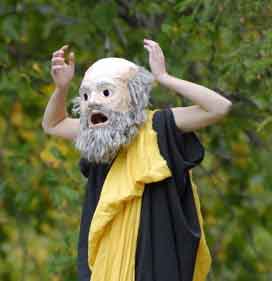 |
| Plate 12 Brittany Costa as Socrates. |
The fact that the masks worked so well unamplified in a Greek theatre of Dionysian dimensions gives strength to the notion that we have come up with a construction method close to that of the Greeks. The masks are light and not uncomfortable to wear, even for inexperienced actors. The "melting effect," so famous a problem of the vase evidence for masks, happens in life: audience after audience commented about how quickly they forgot that the actors were wearing masks. Our work with these masks confirms the belief of Michael Chase that cloth stiffened with glue is the most likely ancient technique for theatrical masks. We were also following the work of C. W. Marshall and those cited by him in "Some Fifth-Century Masking Conventions" (Greece & Rome 46 (1999) pp.188—202), although he speaks of "stuccoed linen" and uses modern plaster-impregnated cast gauze as an analogy. (We found plaster gauze brittle until we had enough layers to make it too heavy, and it does not drape neatly over a whole face and its contours.)
We know we cheated in one way: our prototypes quickly lost their resonant qualities in the late summer humidity of central Virginia and after a short time absorbing the breath of the actors inside the masks. Our solution in order to get the show on its feet was to harden the inside of each mask with an epoxy clear coat. Even without the atmospheric challenges of the American South, the Athenians must have had to solve the problem of masks softening with moisture. Our next experiments will be to see whether we can build masks as effective as The Clouds' masks using only materials available in fifth-century Athens: plaster, shellac, and animal glue on our cloth base. The preliminary results look quite promising, and perhaps even more reliable than the techniques we used for the masks for The Clouds.
We also need to document more accurately the acoustical qualities of the masks, perhaps using a test like the Australian Standards Acoustic Test that Greg McCart cites (http://playingwithtragedy.usq.edu.au/content/PDF/4.1_Field_Research.pdf, published October 17, 2002). As an intermediate measure, we have filmed these masks in action from different angles and distances to show their audibility. On November 29, 2006, Bijaya Pandey and Rebika Shrestha filmed our two actors with a Canon GL2 MiniDV camera, equipped with a PCM Digital 16-bit Stereo microphone. They were instructed to make no sound adjustments, so each of these clips has exactly the same settings, and the sound has not been altered after filming. Again, the voices have a different sound than unmasked voices do, but you cannot say that they are hampered by the masks. The scene is ll. 627—646 in Meineck's translation, and the actors are Brittany Costa as Socrates and Jenny Kreiger as Strepsiades. The distance from the skene to the front row of seats is 55 feet, and Clip 2 has the camera in the front row at the extreme right edge of the audience. Clip 3 is right in the middle: 18 feet farther away, on the sixth row. Clip 4 is 95 feet from the skene and at the extreme left of the audience. We also took the camera as far away as we could, onto the walkway that leads down into our theatre: Clip 5 has the camera back in the centre, but 115 feet away from the actors' entrance.
Clip 2 View from front row.
Clip 3 View from centre, sixth row, 73 feet from skene.
Clip 4 View from extreme left of audience; 95 feet from skene.
Clip 5 View from central walkway leading down into the Theatre; 115 feet from actors’ entrance.
I welcome comments and suggestions for our future work, and for our next original practices production: Sophocles's Electra, the 2008 Randolph College Greek Play.
Amy R. Cohen is Associate Professor of Classics and Director of the Greek Play at Randolph College, Lynchburg, Virginia.
